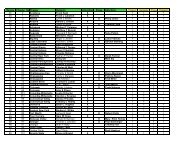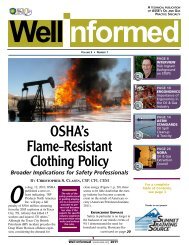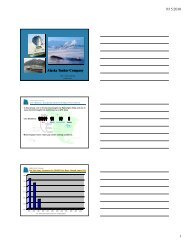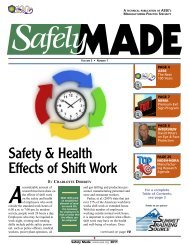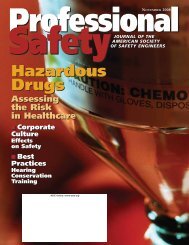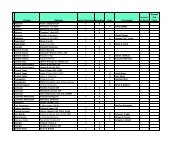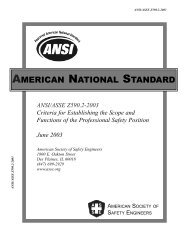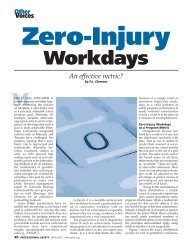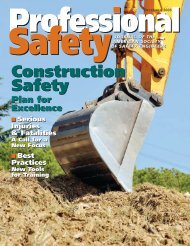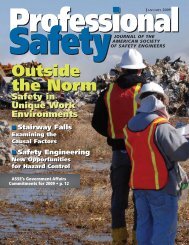Safety 2008 - ASSE - American Society of Safety Engineers
Safety 2008 - ASSE - American Society of Safety Engineers
Safety 2008 - ASSE - American Society of Safety Engineers
You also want an ePaper? Increase the reach of your titles
YUMPU automatically turns print PDFs into web optimized ePapers that Google loves.
Face toFacecontinuedfrom page 49reached out to members who could bringnew voices to the group. The committee isdiverse in its age groups, genders, ethnicheritages, education, life experience, religions,work experiences and length <strong>of</strong>membership within the pr<strong>of</strong>ession andthe <strong>Society</strong>. We are tasked with understandingthe makeup <strong>of</strong> <strong>ASSE</strong> andencouraging its continued diversity.As Region I Vice President, I have triedto balance the needs <strong>of</strong> the chaptersthroughout the region by ensuring geographicrepresentation on the region’sExecutive Committee. In my day-to-dayliving, I encourage safety pr<strong>of</strong>essionals—wherever I meet them—to join <strong>ASSE</strong>. Ihave worked hard to change <strong>ASSE</strong>’simage from a national organization to aninternational organization. The goal is tobe inclusive and to make all members feelwelcome and part <strong>of</strong> <strong>ASSE</strong>.Linda Rhodes (LR): I encourageappreciation for the value that is addedby long-service members and I encouragetheir active participation. Within mychapter, I also take opportunities to recruitmembers who are underrepresented.My activity on the <strong>Society</strong> level hasgiven me an opportunity to mentor others.Those <strong>of</strong> us who look different than“traditional” leaders get many questionsfrom members and potential memberswho are trying to decide whether they fit.We have to be open and honest about thebenefits and the challenges associatedwith active involvement.A member once approached me at theLeadership Conference and asked how Icould be so active on the <strong>Society</strong> levelwithout compromising my work/life balance.We had a great conversation aboutchoices and priorities and she ultimatelycommitted to get more involved. Her concernswere based on misperceptionsabout how much time it would actuallytake to participate on chapter, regionaland/or <strong>Society</strong>-level committees.PS: How have you personally dealtwith diversity and inclusion?JA: On a personal level, I am marriedto a woman who is not from my cultureor society. My children are trilingual. Ihave been a chairperson <strong>of</strong> a Montessoripreschool, which has students from morethan seven cultures and teachers fromvarious backgrounds. I am the only maleon the school’s board; the rest are females<strong>of</strong> Indian, Middle Eastern, <strong>American</strong> andPakistani heritage. I promote understandingand appreciation <strong>of</strong> other cultures andtheir heritage.50 PROFESSIONAL SAFETY AUGUST <strong>2008</strong> www.asse.orgAG: More than 50 contracting companieswork for my company’s Explorationand Production Development Directorate,and contractor employees represent manynationalities. This presents many challenges,so I have adopted these steps todeal with diversity at my workplace:1) Assess diversity in the workplace.The first step dealing with any issuestarts with the assessment <strong>of</strong> it. We conductedthe assessment through employmentsatisfaction and needs surveys.2) Develop a diversity in the workplaceplan. The initial assessment and surveyprovided information on diversity issuesas an integral part <strong>of</strong> the managementsystem. The plan has been made comprehensive,attainable and measurable.3) Implement the plan. The diversityplan in my organization has been implementedthrough management commitmentand line management. This hasbeen incorporated in every aspect <strong>of</strong> theorganization’s function and facilities.4) Reassess the diversity plan. Periodicallyreassessing the plan has helped usevaluate and improve it.KB: I am lucky and thankful that I wasraised in a diverse community and underdiverse circumstances. I grew up in a collegetown that celebrated diversity. Mymom is a journalist who exposed me tomany incredible experiences. I now havethe same opportunity with my children.I think we can all recount negativeexperiences as a result <strong>of</strong> personal, organizationalor governmental prejudices. Forme, it was just another challenge to makemyself and those around me better. I nowhave the responsibility <strong>of</strong> influencing theminds <strong>of</strong> my two daughters to be open.Each day at work, I am blessed to workwith people <strong>of</strong> such tremendous diversity.One <strong>of</strong> my most rewarding opportunitiesis to work on initiatives <strong>of</strong> accessibility forpeople with disabilities. Our goal is tomake our parks as accessible and inclusiveas safely possible.DB: Living in an area with an extremelydiverse cultural base, I havelearned (perhaps unconsciously) tounderstand and appreciate the diversity<strong>of</strong> others and how this understandingcan benefit me. Where I live, the majority<strong>of</strong> people can be considered a “mixedplate”—very few individuals are <strong>of</strong> a singlerace or background. This forces us tolearn a variety <strong>of</strong> traditions and histories.That understanding has made it mucheasier to work effectively with others.Living in Hawaii—on what we fondlycall “the rock”—we tend to travel aroundthe world more than most. In our travels,we encounter various problems because<strong>of</strong> our visual appearance and our tendencyto speak rapidly. My ethnic backgroundis Hawaiian, English, Irish andSpanish, and my children inherited Portuguesefrom their father. Stereotyping is aproblem. To many in other places, aHawaiian is perceived to be <strong>of</strong> Asianancestry, which we are not. Depending onwhere we visit, we encounter changes inattitude and treatment because <strong>of</strong> how welook and speak. When we tell them weare from Hawaii, things change.Two <strong>of</strong> my children have attendedcollege on the mainland and they haverelated to me things that have happenedto them and things they have observed.They have grown up understanding andaccepting the differences in people andappreciating the diversity around them,so they sometimes find it hard to understandwhy others do not feel the waythey do. They are proud <strong>of</strong> their multiculturalheritage, and they share theirexperiences as <strong>of</strong>ten as they can. Theyhave not let prejudices and misunderstandingsaffect them.RM: When I first came to the U.S. toattend college in 1974, I was one <strong>of</strong> thefew Hispanics among several thousandstudents at Oklahoma State University.For a couple <strong>of</strong> years, I was the onlyHispanic in the School <strong>of</strong> Protection and<strong>Safety</strong>. I had to work hard to understandothers and to make myself understood. Istarted as “the Hispanic guy,” but myperformance in school and my socialinteractions with other students helpedme gain their acceptance.I joined the International StudentAssociation and became an <strong>of</strong>ficer to learnhow the system worked. Later I organizedand became the first president <strong>of</strong> theLatin <strong>American</strong> Student Association. Theactivities we conducted helped others atschool and in the community betterunderstand the Hispanic culture, food,music and art.I have experienced a few unpleasantsituations that happened because I amHispanic. Today, they are insignificantmemories. I concentrate on the excellentopportunities and rewarding experiencesthis great country and <strong>ASSE</strong> have blessedme with and dedicate my efforts to continuethe improvement <strong>of</strong> diversity.TN: The way I handle diversity haschanged as I have grown. As a child, Ibecame adept at being a chameleon to fitin. I changed my accent, I learned newlanguages and I learned to keep low toavoid becoming a target.As an adult, I continued to use theskills I developed as a child—and Iadded education and communicationskills to my toolbox. I learned to standup for myself and what I believed in.Because <strong>of</strong> my educational and personalexperiences, I was able to teach my childrentolerance. I work hard to ensurethat people feel included and that theyhave a voice. In addition, I supportdiversity by earmarking my annual<strong>ASSE</strong> Foundation donation for the <strong>ASSE</strong>Diversity Committee Scholarship.



